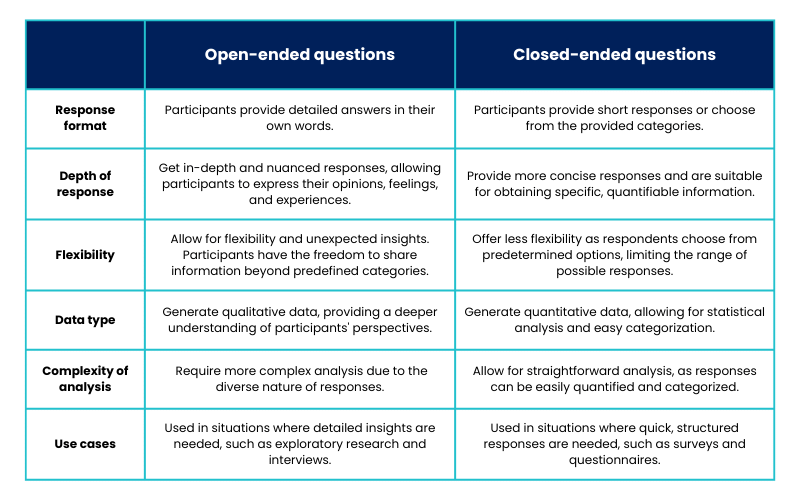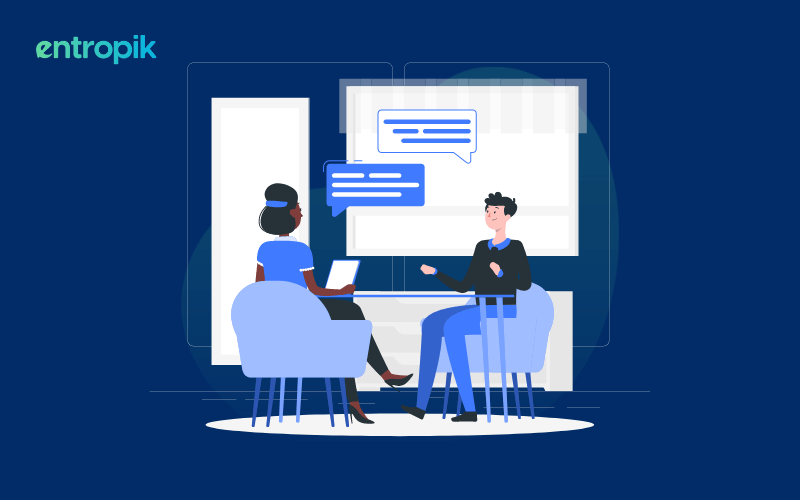We spend hours crafting surveys, designing questionnaires, and analyzing data with laser focus. However, the cold, hard truth is that this data can only tell you what users do, not why they do it. To bridge the gap and understand the motivations and emotions that truly drive user behavior, we need to delve deeper. Open-ended questions are your secret tool to help you understand by inviting users to express themselves in their own words.
What is an open-ended question?
Open-ended questions are queries that prompt a detailed, extensive response rather than a simple "yes" or "no" answer. These questions encourage participants to share their thoughts, opinions, and experiences in their own words, fostering a more comprehensive and nuanced understanding of their perspective.
Open-ended questions typically begin with words like "how," "what," "why," or "tell me about," allowing respondents to express themselves freely and provide detailed insights. This approach is commonly used in qualitative research, user interviews, surveys, and discussions to draw out rich and diverse information from participants.
Open-ended questions vs closed-ended questions

When should you ask open and closed-ended questions?
The choice between open-ended and closed-ended questions depends on the goals of your research, the information you seek, and the stage of your interaction with participants. Here's a general guide:
Open-ended questions are suitable for:
Exploration and understanding: Use open-ended questions when you want to explore a topic in-depth and gain a comprehensive understanding of participants' perspectives.
Early research stages: At the beginning of your research or interview, open-ended questions help build rapport and allow participants to share their thoughts freely.
Complex subjects: For complex or nuanced topics where you want detailed responses, open-ended questions encourage participants to elaborate.
Closed-ended questions are suitable for:
Collecting quantitative data: When you need specific, quantifiable data or want to gather responses that are easy to categorize, closed-ended questions with predefined answer options are effective.
Survey design: In surveys, closed-ended questions are often used for efficiency, especially when dealing with a large number of participants.
Verification: When you need to verify specific information or test hypotheses, closed-ended questions can provide clear, standardized responses.
Mixed approach:
In many cases, a combination of open-ended and closed-ended questions is beneficial. Start with open-ended questions to gather rich insights, and then use closed-ended questions to quantify and categorize specific aspects. This balanced approach allows for depth and structure in your research.
Advantages of open-ended questions
Rich insights
Open-ended questions encourage participants to provide detailed and nuanced responses, offering researchers deeper insights into their thoughts, feelings, and experiences. This richness of information goes beyond simple yes/no answers.
User-centric exploration
By allowing participants to express themselves freely, open-ended questions empower users to share aspects of their experiences that researchers may not have anticipated. This user-centric approach ensures that the study explores areas relevant to participants.
Flexibility and adaptability
Open-ended questions provide flexibility, allowing researchers to adapt the line of questioning based on participants' responses. This adaptability ensures that researchers can follow interesting leads and delve deeper into specific topics as they arise.
Understanding context
Participants can provide context and elaborate on their responses, helping researchers understand the reasons behind certain behaviors or preferences. This contextual information is valuable for making informed design decisions.
Uncovering unconscious needs
Participants might reveal needs, desires, or challenges they were not consciously aware of when responding to open-ended questions. This uncovering of subconscious aspects adds a layer of depth to the research findings.
Encouraging engagement
Open-ended questions engage participants more actively in the research process. This engagement fosters a collaborative atmosphere, making participants feel heard and valued, which can contribute to more honest and thoughtful responses.
Validating quantitative data
When used in conjunction with quantitative methods, open-ended questions can help validate or provide context for numerical data. They offer a qualitative dimension that complements quantitative findings, providing a more comprehensive understanding.
Iterative design improvement
Insights gathered from open-ended questions can inform iterative design improvements. Understanding users' perspectives and preferences at a deeper level enables designers to refine and optimize products for enhanced user satisfaction.
Building empathy
Open-ended questions contribute to building empathy with users. Researchers gain a more profound understanding of the emotional aspects of user experiences, fostering a human-centric approach to UX design.
Enhancing user-centered design
Overall, open ended questions support a user-centered design approach by prioritizing the user's voice and perspective. This leads to products and experiences that are more aligned with user needs and expectations.
How to ask open-ended questions
Asking effective open-ended questions is crucial to elicit detailed and insightful responses. Here are some tips on how to ask open-ended questions:
Start with "How," "What," "Why," or "Tell me about"
These question starters encourage participants to provide detailed information rather than a simple yes or no.
For example: Instead of asking, "Did you enjoy the experience?" ask, "How would you describe your experience?"
Be clear and concise
Frame your questions in a clear and straightforward manner to ensure participants understand what you're asking.
For example: Instead of a vague question like, "Anything else you want to share?" be more specific, such as, "Is there any specific aspect of the product that stood out to you?"
Avoid leading questions
Refrain from phrasing questions in a way that leads them to give a particular answer. Avoiding leading questions ensures that participants provide unbiased and genuine responses.
For example: Instead of asking, "Don't you think the new feature is great?" ask, "What are your thoughts on the new feature?"
Encourage elaboration
Follow up on responses with additional probes to encourage participants to elaborate on their answers. This helps you delve deeper into their perspectives.
For example: If a participant mentions a positive experience, follow up with, "Can you provide more details on what made that aspect enjoyable for you?"
Use scenario-based questions
Presenting hypothetical scenarios can prompt participants to think about situations in a more concrete and detailed manner.
For example: "Imagine you are using this product in a real-world scenario. How do you envision it fitting into your daily routine?"
Consider context
Tailor your questions to the context of the research and the participant's background. This ensures relevance and encourages thoughtful responses.
For example: If researching a mobile app, ask, "How do you typically use mobile apps for [specific purpose]?"
Create a comfortable environment
Establish a rapport with participants to make them feel comfortable sharing their thoughts openly. A relaxed atmosphere encourages open-ended responses.
Use neutral language
Ensure that your questions are phrased in a neutral manner to avoid influencing participants' responses. This helps in obtaining unbiased and honest feedback.
For example: Instead of saying, "Don't you find the interface confusing?" ask, "How would you describe your experience with the interface?"
Vary question types
Mix open-ended questions with other question types in your research. This adds variety to the interaction and helps maintain participant engagement.
Limit question length
Keep your questions concise and to the point. Long-winded questions can confuse participants and may lead to less detailed responses.
For example: Instead of a lengthy question like, "Considering your past experiences, including the challenges you may have faced, can you describe how this product compares?" break it down into more focused queries.
Allow for silence
After posing an open-ended question, give participants time to gather their thoughts and respond. Silence can be a powerful tool, encouraging participants to share more detailed insights.
Be mindful of your tone
Pay attention to your tone and non-verbal cues. A friendly and non-judgmental demeanor helps participants feel more comfortable sharing their perspectives.
{{cta-trial}}















.jpg)























































































